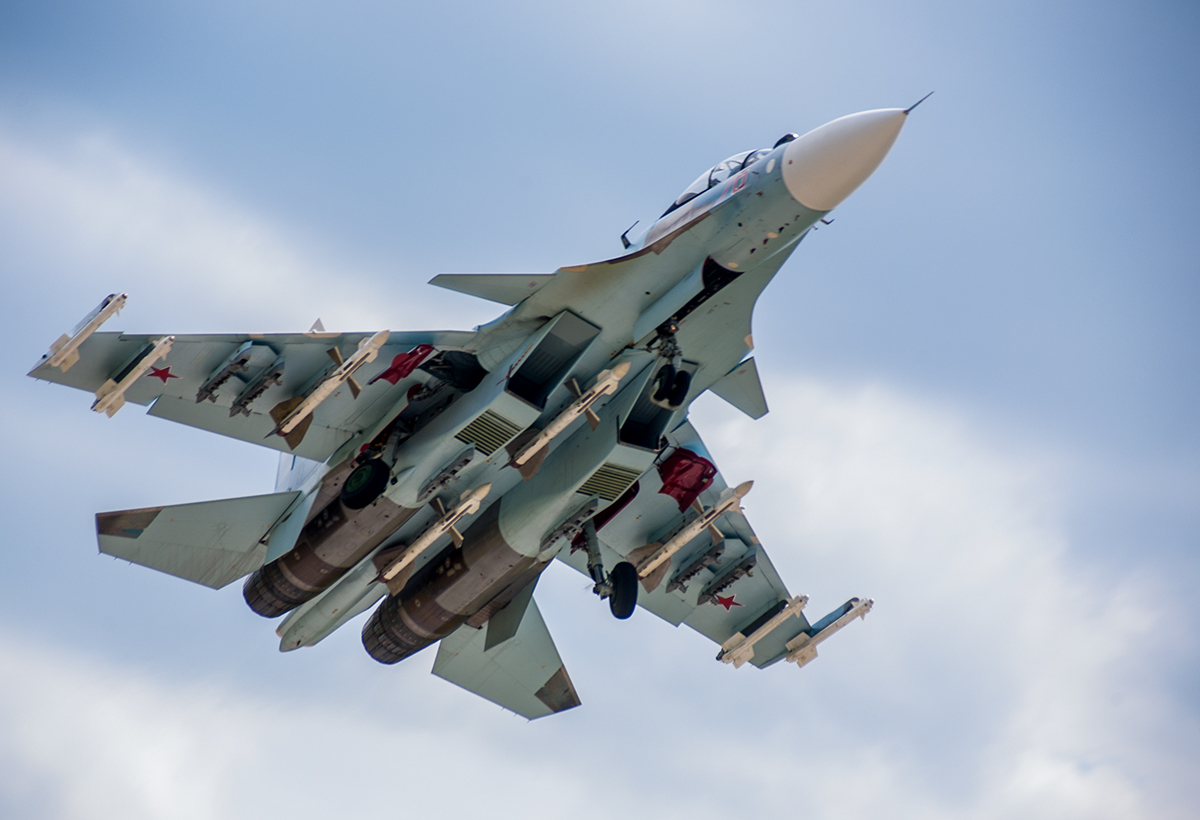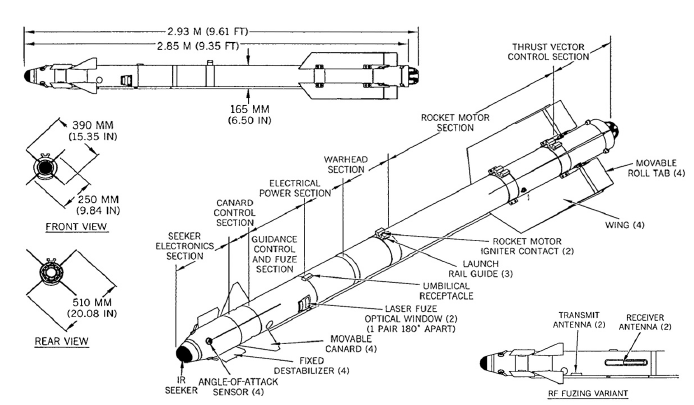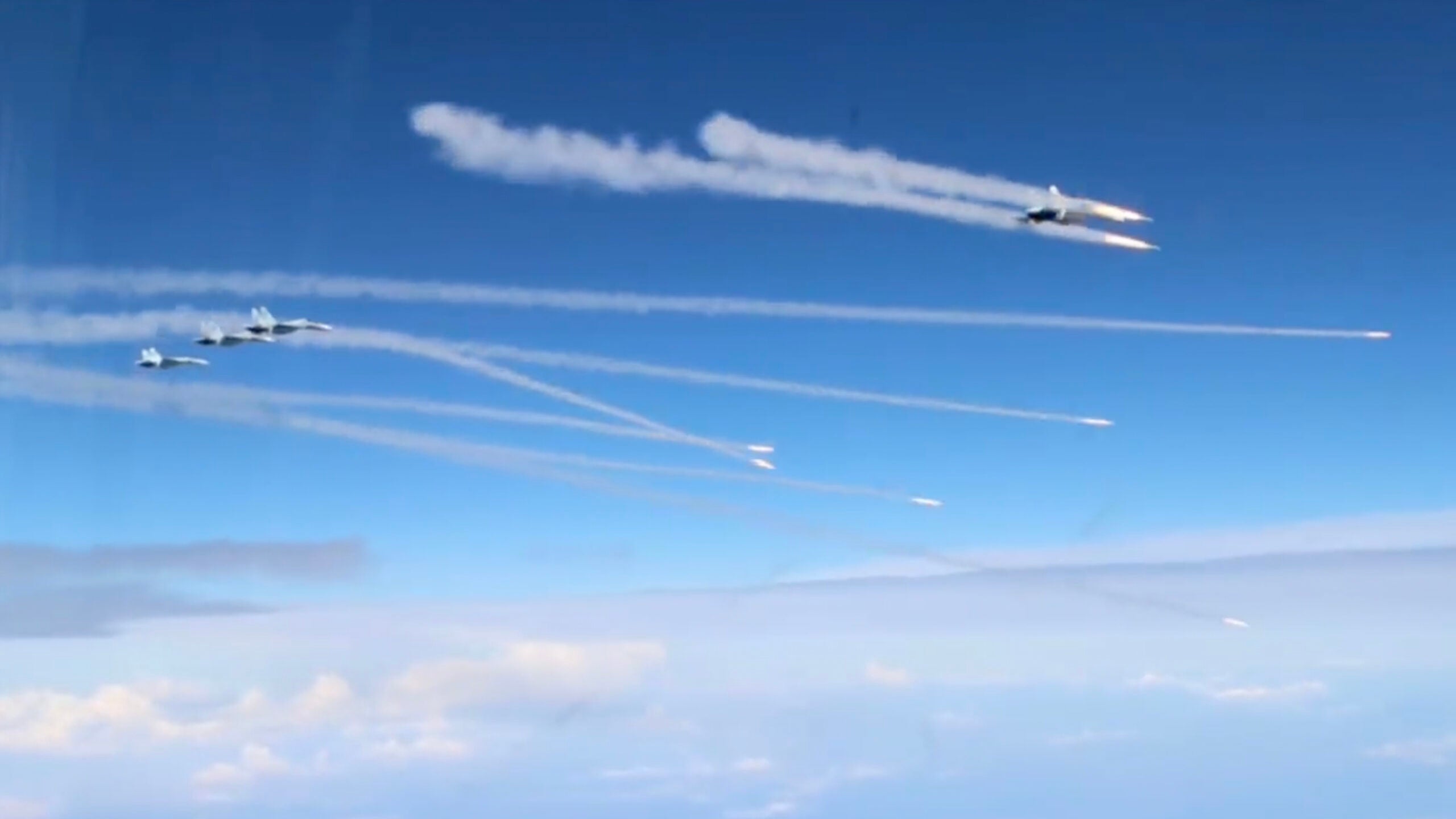The launch of an air-to-air missile from a fighter jet is normally a pretty impressive sight, especially when we have the chance to watch from the cockpit as the weapon streaks off its pylon and races toward the target. A two-ship flight of fighters each launching a missile can be more spectacular still, but the Russian Aerospace Forces have taken things up a notch with the very rare launch of eight missiles almost simultaneously from four Flanker multirole fighters.
The footage was posted to the Russian Telegram messaging site today by a user named Fighterbomber, some of whose material we’ve also looked at in the past. The video, which is linked here, was taken from the cockpit of another Flanker-series jet, but we don’t know exactly where or when. It shows a formation of four Russian Aerospace Forces twin-seat Su-30SM Flanker aircraft. Each launches a pair of air-to-air missiles, which appear to be infrared-homing R-73 (AA-11 Archer) or R-74 series weapons. A weapon of the same type is seen on an underwing station in the pilot’s mirror of the camera-equipped Flanker.

The commentary supplied with the video offers little in the way of detail, but suggests the missiles were fired at an M6 target, a bomb-like device dropped from another aircraft before descending slowly under a parachute. It then presents an infrared or radio-frequency target that can be engaged by air-launched missiles or ground-based or naval air defenses. The photo below shows a Su-35S apparently carrying four M6 targets, which use the same casing as 220-pound SAP-series bombs. It should be noted that in the video we don’t get to see how many targets were being engaged, the distance to the target(s), or whether the various missiles all guided successfully for simulated kills.
The launch of eight missiles in rapid succession is certainly dramatic, but the close proximity of the jets (one of them deploys its ‘barndoor’ air brake to help keep formation) has little in common with a genuine tactical scenario. While putting up a ‘wall’ formation to close down a huge swath of airspace is a viable tactic and was used to great effect in Operation Desert Storm, the separation between the aircraft would be much greater, both for their effectiveness and to improve their own chances of survival.
The Russian live-fire drill, therefore, may well be tailored to a significant degree for public consumption. Photo opportunities like this are not unfamiliar, with several instances of four-ships of U.S. Air Force F-15 Eagles each firing a missile. Of course, these kinds of events do still provide some valuable training opportunities.
A chance to fire a live missile is relatively uncommon, but it provides useful training, giving the pilot the feel of real-world air combat and beating anything the simulator might be able to offer. Adding more jets and more missiles increases the complexity and requires skillful cooperation.

Training events like the one seen here are not without hazard, however; there have been some notable ‘blue-on-blue’ incidents during training. Last year it emerged that a Russian Aerospace Forces Su-35S Flanker fighter jet gunned down a Su-30 with its onboard cannon during a close-air-combat training mishap in the Western Military District. In another incident in 2017, but not revealed until two years later, a Russian Aerospace Forces MiG-31 Foxhound interceptor shot down its wingman using an R-33 long-range air-to-air missile over a training range close to Russia’s border with Mongolia.
In the United States, at least, live-fire exercises often take place prior to a fighter squadron being deployed to an operational theater, and it could be the case that the pilots involved are headed to Syria, where the Russian Aerospace Forces maintain a significant presence and have assembled considerable combat experience.

Meanwhile, of the regular air combat exercises in Russia with significant live-fire elements involving air-to-air missiles, the most prominent is probably the Ladoga series, named after the lake and region in the Republic of Karelia and Leningrad Oblast in northwestern Russia.

Live-fire exercises like this also serve to check the reliability and effectiveness of the missile and its interface with the aircraft.
That may be particularly relevant depending on the type of missile used. In addition to the proven R-73, which has been in use since the early 1980s, there is also the more modern R-74M, which officially entered service in 2012. This weapon looks outwardly almost identical to the R-73 but has a new, two-band infrared seeker. This provides increased seeker range and an expanded off-boresight capability, reducing the possibility of the enemy aircraft escaping it in a tight-turning dogfight.

The age of the R-73s in the Russian armory means that it makes sense to test their functionality. Meanwhile, the development of the R-74M, available in smaller numbers, has been plagued by issues with the seeker. This was originally provided by a company in Ukraine, which ended its cooperation with Russia after Moscow’s annexation of Ukraine’s Crimea region in 2014, followed by its support of separatists in Ukraine’s eastern provinces.
Russia has since switched its short-range air-to-air missile efforts to the K-74M2, optimized for internal carriage by the Su-57 Felon new-generation fighter, with reports of an all-new Izdeliye 300M missile in development, too.

Should we find out more about the video and the background to it, we will let you know. In the meantime, however, the Russian Aerospace Forces have provided an eye-catching reminder of the important training that goes to ensure pilots and maintainers are at the top of their game, and the hardware they are responsible for functions as it should.
Contact the author: thomas@thedrive.com
